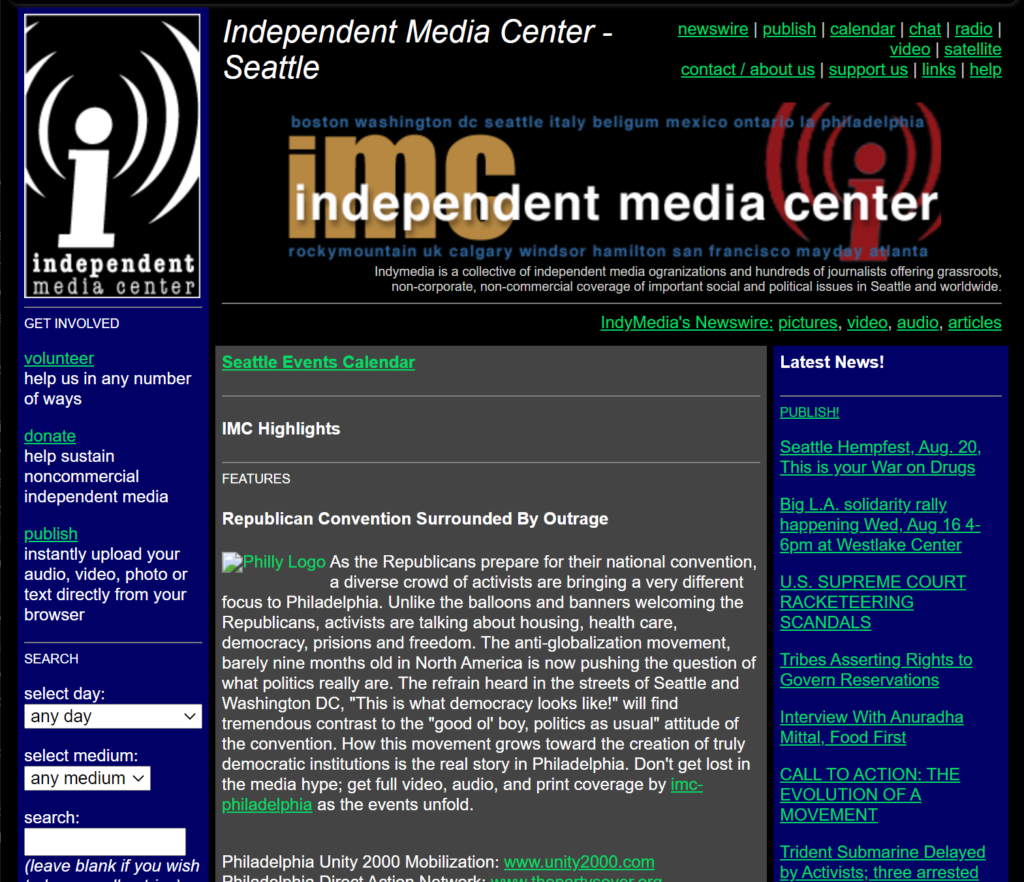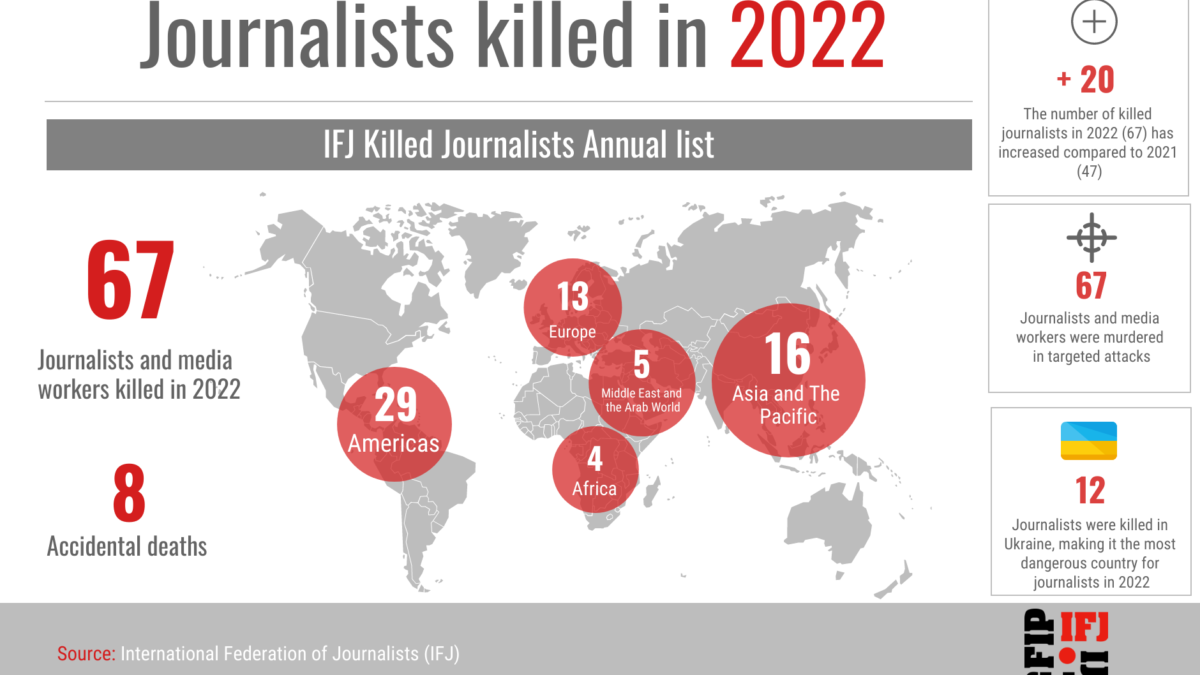The Battle of Seattle: 20 years later
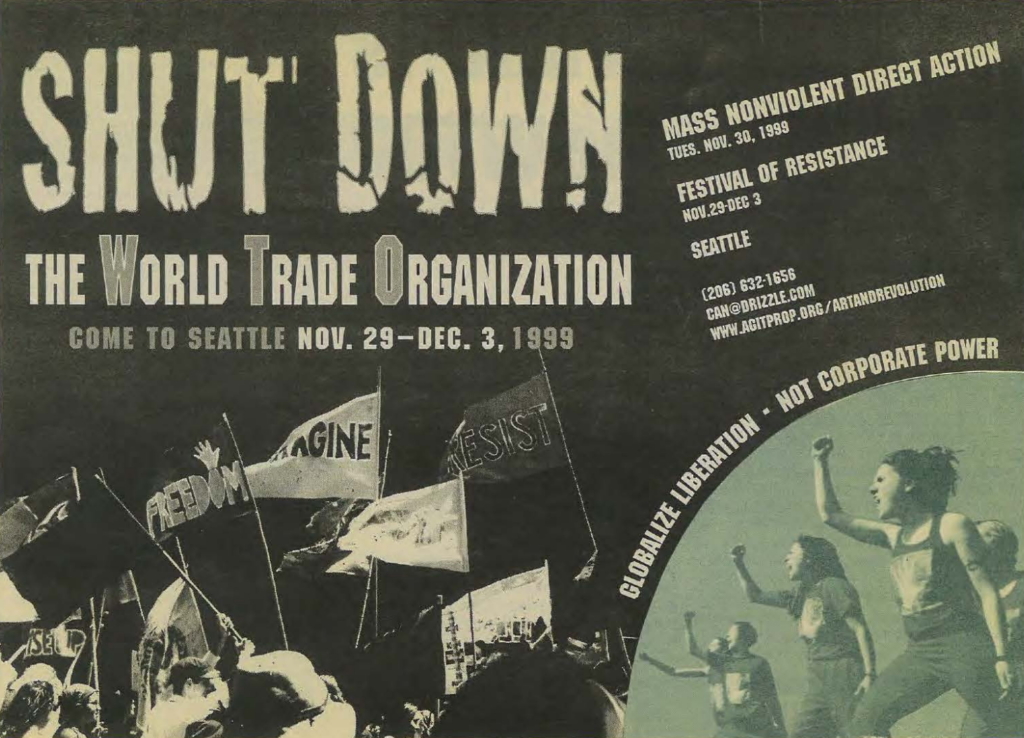
By James Galasyn
30 November 2019
(Desdemona Despair) – It was twenty years ago today: the protests against the third WTO Ministerial Conference, held in Seattle on 30 November 1999. The ongoing clashes between protesters and the Seattle Police Department came to be known as the Battle of Seattle, and they set the tone of protest movements for the 21st century.
I was there, with a couple of friends. The twenty-year anniversary has me thinking about the prospects for direct action and mass protests for averting the worst possible futures.
What we saw
We started at Memorial Stadium at Seattle Center, with the Labor march. The stadium of 12,000 people filled up completely, there were speakers, and then we headed out. I was there with WashTech, the Washington Alliance of Technology Workers – still a member! Traditional Mayan dancers led the way, in full ceremonial regalia, and the air was thick with copal incense. We marched down 4th Avenue, filling the width of the street, dancing to the percussion of the Infernal Noise Brigade. When we walked beneath the towers of the Westin hotel, we could see the WTO delegates, way up on the top floor, lined up at the windows and looking down at us.
We marched with people dressed as sea turtles, who were protesting the effect of WTO rules on national environmental laws. We knew that other marches were coming down from Capitol Hill and up from the south, and ours would converge with theirs at Westlake Center. The mood was joyous.
We approached Westlake Park. There was some confusion about where to go next. We saw a man directing us and pointing to our left. He was saying, “Labor march this way, rubber bullets and tear gas that way.” That sounded ominous, so we went left. But after hearing the booms of stun grenades, we knew that we had to check it out.
We followed the booms and walked toward 4th and Pike. The windows of shops were shattered, and newspaper boxes were scattered around. We didn’t know it at the time, but black bloc anarchists had swept through downtown before the big marches started, smashing things.
The standoff
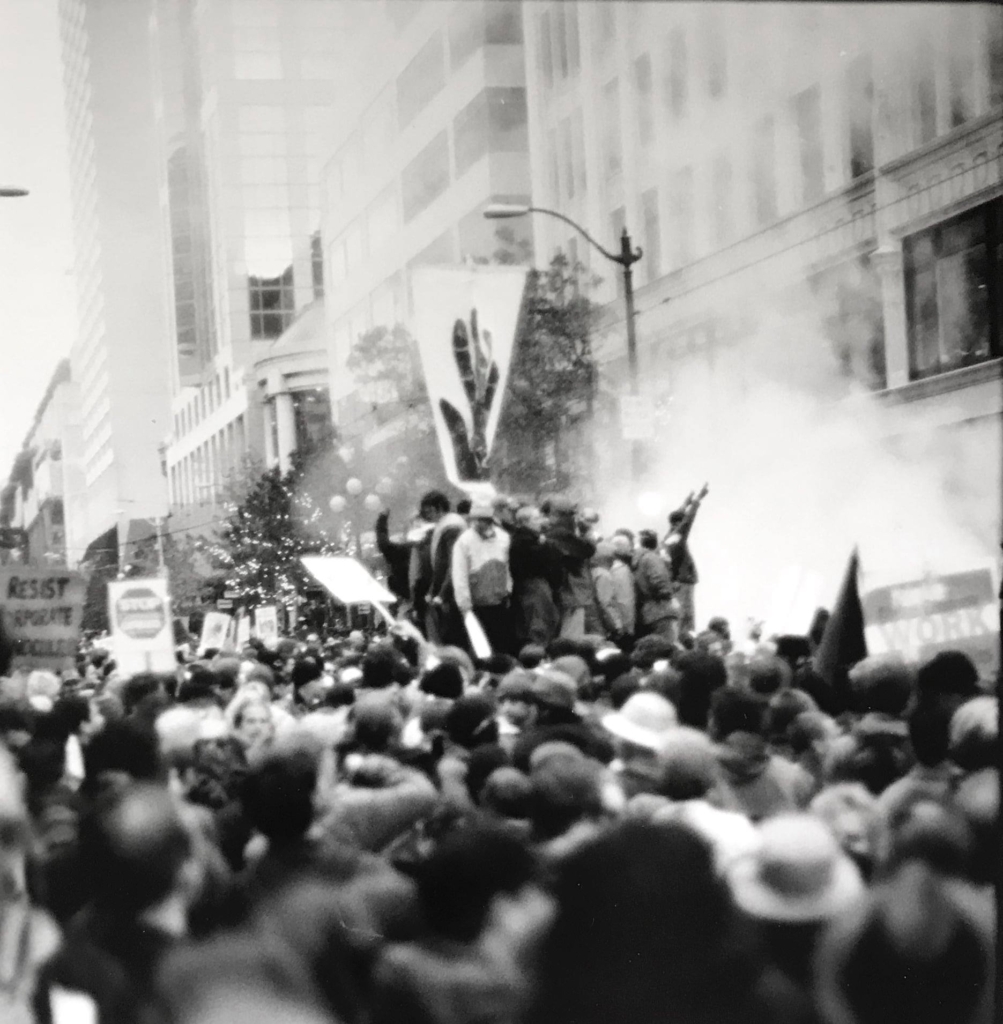
A huge crowd filled the intersection at 4th and Pike. We couldn’t see past them, but it was loud, with shouting and drumming punctuated by booms from stun grenades. There were rubber bullets in the gutter. The sting of pepper spray hit our noses. Medics and legal people darted among the protesters. We pushed through the crowd to get a better look.
In the middle of the intersection, the Seattle Police had established a defensive circle. They were surrounded by thousands of people; this was the location where the marches had converged. The police were completely cut off from the rest of the city.
We worked our way around to the south of the crowd. A man in shamanic garb stood facing the intersection, chanting. We made our way west down Pike to 3rd Avenue and started looking for a place to eat, because by this time we were very hungry. The street was abandoned, with debris scattered around. A nearby Mexican restaurant was packed with people, but we managed to get some pizza at another place and went back to the action.
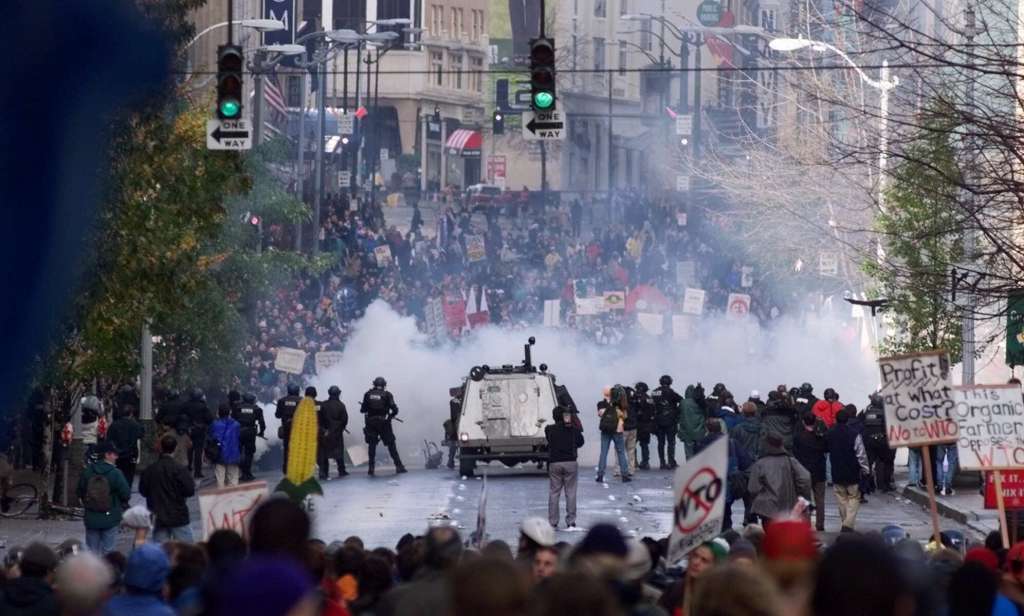
The situation had escalated. Protesters had set a dumpster on fire and pushed it into the intersection, to try to break the police circle. We skirted the standoff and headed east on Pike to another standoff, where protesters had surrounded the entrance to the Sheraton hotel and filled the intersection at 6th and Pike. A police cordon prevented people from entering or leaving. Delegates stood in the lobby, peering out past the police at the sea of people. Some protesters had climbed onto the Niketown awning, where the soon-to-be famous kid wearing Nike sneakers kicked at the Big “N” on the sign to break it off.
We bounced around downtown, between the various actions. The streets alternated between the “warm thrill of confusion”, in the words of Pink Floyd, and eerie emptiness. Many store windows were shattered. As the sun set and Fall darkness closed in, the chaos continued. Back at the Sheraton, we were immersed in the crowd and the dark, and at this point, any direction or control of the protests had evaporated. One man defended the door of a jewelry shop while others tried to smash their way in. The boom of stun grenades set off waves of panic through the crowd. There was a real danger of being trampled to death. The crowd darted this way and that, changing direction randomly. The three of us grabbed hands and walked a straight line north on 6th, as the crowd surged around us, jostling and banging into us, almost hard enough to knock us over. One of the most frightening moments of my life.
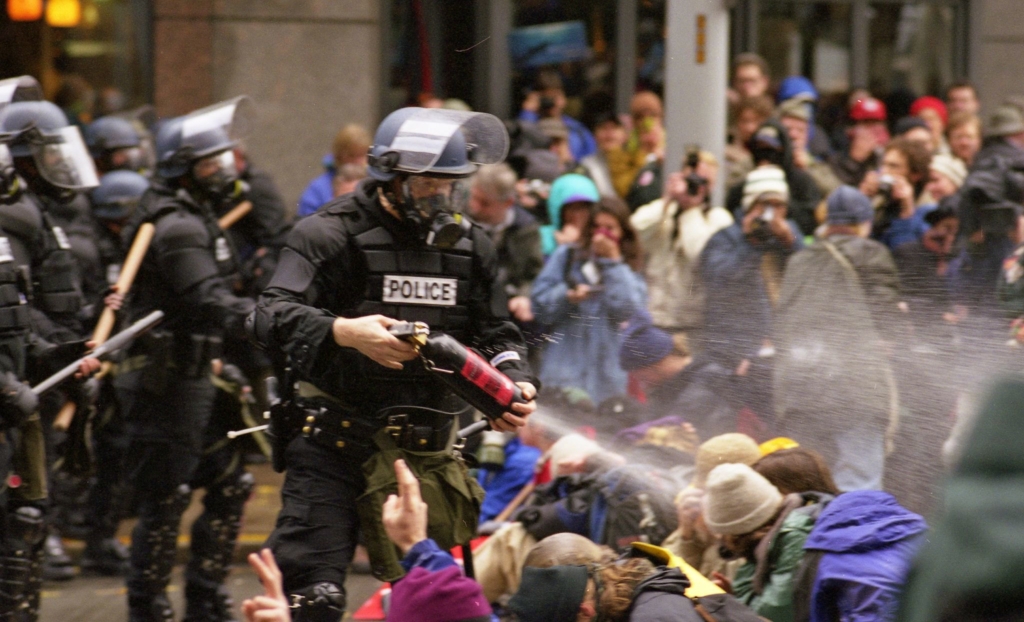
After what seemed like hours, we emerged from the crowd and made our way back to the Seattle Center parking garage. We went home and watched the news coverage, as protesters and police battled for control of the Pine St. bridge over I-5. There were running street battles that continued into the night. We scoured seattle.indymedia.org for the “real” news uploaded by citizen reporters in real-time from the streets, something that was entirely new on the internet landscape in 1999.
The outcome
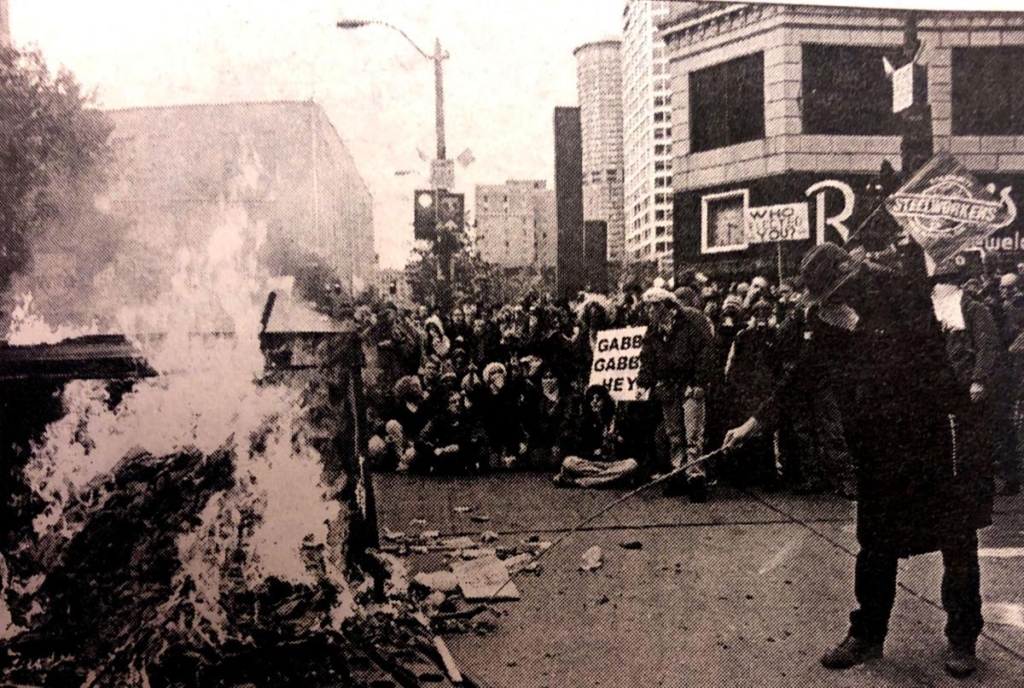
The protests succeeded in shutting down the Ministerial, because the delegates couldn’t physically travel to the meeting venues. One result of N30 is that the WTO Ministerials have been moved to places that are completely inaccessible to protesters, like Qatar.
Reflecting on what was accomplished during that week, I don’t know if it made much difference. Ten years later, the Arab Spring protests happened, followed by the wave of violence and instability known as the Arab Winter. Twelve years later, the Occupy Wall Street protests came and went. Twenty years later, the global wealth gap has increased, and the most reactionary populist forces have seized control of the U.S. and other nations, like the U.K., Russia, India, Brazil, the Philippines, and Eastern European nations like Hungary and Poland. China has a president for life and has implemented an automated mass surveillance state that targets ethnic minorities for internment camps.
In parallel, people are rising up in places like Chile, Ecuador, Lebanon, and Hong Kong. The Extinction Rebellion protests and the Climate Strikes are bringing millions of young people into the streets. It remains to be seen whether this new wave of mass action can make a dent, when all previous attempts have failed.
N30 inaugurated a new era of digital citizen journalism and gave us hope that these technologies would be a force of liberation. Twenty years later, propaganda is now distributed through social media, amplified with automation and analytics, and deployed as a new form of weaponry to destabilize democracies. Autocracies have converted the internet into a gigantic surveillance platform, and they use it ruthlessly to target whole regional populations. As always, the promise vs. peril pendulum of technology hangs over us, but in the twenty years since N30, it swings ominously toward peril.
Coverage of the 20th anniversary
There wasn’t a lot of reporting on the 20th anniversary, even in Seattle. Maybe it’s an event that Americans prefer to forget. But it shouldn’t be forgotten.
Here’s some of the coverage that various publications ran to commemorate N30:
- Seattle PI: Impact of WTO protests in Seattle still felt 2 decades later
- Seattle Times: How The Seattle Times covered the WTO Seattle protests
- City archive: World Trade Organization Protests in Seattle
- Democracy Now: “Don’t Hate the Media, Be the Media”: Reflections on 20 Years of Indymedia, a Radical Media Movement
- Democracy Now: 20 Years After The Battle of Seattle: Vandana Shiva & Lori Wallach on Historic 1999 WTO Protests
- Indypendent: How We Created A Festival Of Resistance at the 1999 Battle of Seattle
- The UW Daily: On its 20th anniversary, what the WTO protests taught us about capitalism, civil disobedience, and the SPD
- RealChange: This is what victory looks like: Why we celebrate WTO+20
- South Seattle Emerald: Remembering the Battle in Seattle 20 Years Later
